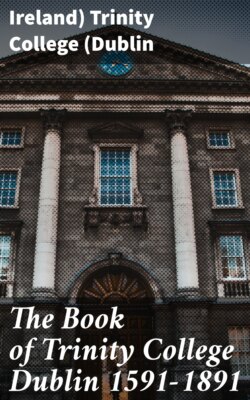Читать книгу The Book of Trinity College Dublin 1591-1891 - Ireland) Trinity College (Dublin - Страница 9
На сайте Литреса книга снята с продажи.
ОглавлениеCHAPEL PLATE. (DATED 1632 AND 1638).
Before closing this chapter, we may say a word upon the changing aspect of the College and its surroundings, especially College Green. The foundation of the College soon brought with it a desire to build houses in its neighbourhood. But in Bedell’s diary we find that the first permission given by the Corporation to build houses close to the gate was frustrated by the students raiding upon the works, and carrying the building-plant into the College. The builder, indeed, recovered it by the interference of the Provost, but whether the building proceeded is doubtful. Still, we hear of Archbishop Ussher lodging in College Green in 1632, a very few years after; and a lodging fit for the Primate can have been no mean dwelling. There were several sites granted on the north side of Dame Street by the Corporation to gentlemen of quality, who built houses, with gardens stretching behind them to the river. I have found mention of three of these before 1640. Presently two larger mansions were erected there—Clancarty House, at the foot of the present S. Andrew’s Street, and opposite it Chichester House, always a large mansion, often used for Courts, and even Parliaments, till the present remarkable building was set upon its site. It was one of the objections urged in 1668 to Trinity Hall (the site of the present S. Andrew’s Church) for holding students, that they could not hear the College bell owing to the number of intervening houses. Thus Dublin must have been rapidly growing out in this direction.[63] There are houses in Dawson Street and Molesworth Street whose gables show them to belong to the 17th century. So likewise in the streets off South Great George’s Street there are still many houses which bear the clear character of Dublin building from 1660 to 1700. All the churches were remodelled or rebuilt in the end of this or in the succeeding century. But, as I have already said, there was as yet no thought of stately or ornamental house architecture. The existing blocks of that date in Trinity College (Nos. 22-31) show what was accomplished, and though far better than the buildings of “Botany Bay,” which came a century later, are nevertheless mainly interesting from their date as marking an epoch in this History. There is no hint that the other lodgings for students, since taken down, were in any sense ornamental.
I turn, in concluding this chapter, to the interesting question of the recognition of sports and games among the students—a recognition which reached its climax under Provost Hutchinson. The following passage gives us some facts and dates:—
There does not appear to have been any arrangement for the recreation of the Students inside the College until 1684, when we find the following entry on August 13:—“The ground for the Bowling-green was granted, and the last Commencement supper fees were allowed towards the making of it.” The bowling-green, which was near the present gymnasium and racquet-court, and probably on the site of the existing [lawn] tennis-courts, was maintained until early in this century, and a portion of the entrance fees of Fellow Commoners was applied to maintain it. On July 28, 1694, leave was given to build a fives-court at the east end of the Fellows’ garden. In Brooking’s map of Dublin there appears to have been, in 1728, a quadrangular walled-in court on the site of the present New Square, for the recreation of the Students. There were two gates giving access to this in the arches under numbers 23 and 25 in the Library Square, which is the oldest existing part of the College, and which was erected after [about] 1700. As the Students were prohibited from going out into the city without leave, it was obviously necessary that opportunities should be given for out-door amusements within the bounds; and the College Park had not been at this time laid out and planted. A number of small paddocks occupied at this period the site of the present Park; and the College Park, as we have it now, was first formed and planted with trees in 1722.[64]
Some comment upon this passage seems desirable. In the Elizabethan and Jacobean College recreations for the students were not only ignored but forbidden. Young men came there and were maintained at the expense of the Institution, not to play, but to work, as I have above explained. This strictly theological notion was now giving way to a secular aspect of things, which tolerated the residence of students in the city,[65] and received wealthy young men, who came to spend, not to earn money. The facts just quoted are therefore interesting in showing that this change of spirit was now accomplished. For in colleges outward acts follow slowly upon new convictions.
